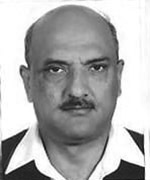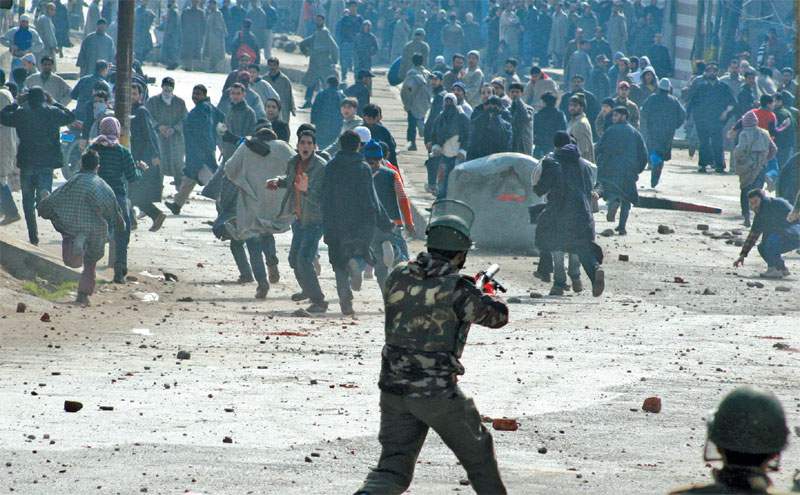Both quick wit and less lethal equipment are necessary to ensure that protests don’t turn violent
 S.K. Sood
S.K. Sood
During our induction training in the BSF in 1977, an elaborate demonstration was laid down to explain the methodology of crowd control to us.
A group of people depicting police were confronted by noisy slogan shouting crowd aggressively advancing towards them. The commentator kept informing us about various types of crowd and actions to be taken at each successive stage. The crowd was informed to disperse as Section 144 had been imposed. They were regularly being cautioned to calm down and send their representative for discussion. They were informed that police will be compelled to use force if the crowd crossed the tape laid down in the area.
We were informed that the tape would be replaced by a landmark in actual conditions. We were told that force should not be used indiscriminately, and the police should identify leader of the crowd and watch his activities to discern crowd behaviour. The commentator also informed us that any use of force will have to be only after explicit orders from the magistrate who must not be allowed to go out of sight. The crowd did not pay heed and crossed the line. The magistrate was duly asked to authorise use of force. The police upon receiving the orders opened with a single round of rifle aiming at the lower limbs of the leader. The leader fell down and the crowd dispersed. The leader was immediately rushed for medical attention after first aid.
During the post demonstration briefing we were informed about the nuances of practicing ‘use of minimum force’. It was also explained that the stages of lathi charge and tear smoke munition were not included in the demonstration as BSF is an armed force and does not carry lathis.
The right to protest peacefully is guaranteed by the Constitution of India. Articles 19(1)(a) gives to all citizens the right to freedom of speech and expression, and Article 19(1)(b) gives the right to assemble peaceably and without arms subject to reasonable restrifctions under Articles 19(2) and 19(3), which includes restrictions to maintain public order among other things.
The Indian Penal Code (IPC) 1860, the Police Act 1861 and the Code of Criminal Procedure (CrPC) 1973 empower the law enforcing authorities to deal with such agitations, protests, and unlawful assemblies. The crowd or an assembly declared unlawful can be dispersed by use of force under the provisions of Sections 129-132 of the CrPC including use of armed forces and protection against prosecution.
The CrPC Section 129, states ‘Any Executive Magistrate or officer in charge of a police station… may command any unlawful assembly, or any assembly of five or more persons likely to cause a disturbance of the public peace, to disperse; and it shall thereupon be the duty of the members of such assembly to disperse accordingly’. The section also provides for use of force if such unlawful assembly does not disperse or displays intention of not dispersing.
The armed forces if used for dispersing the crowd are required to ‘use as little force, and do as little injury to person and property, as may be consistent with dispersing the assembly and arresting and detaining such persons’ as per the provisions of Section 130 of the CrPC.
Words ‘minimum force’ do not find mention in any legal documents. The Section 130(3) CrPC obliquely refers to it by use of words like ‘as little force’. The minimum force can be described as minimum actions, including the use of armed force, sufficient to bring a situation under control or to defend against hostile act or hostile intent. All actions must cease as soon as the target complies with instructions or ceases hostile action. The firing of weapons is to be considered as a means of last resort.
The crowd can be defined as ‘a large number of people gathered together in a disorganized or unruly way’. The crowds that the law enforcers have to deal with are unstructured and have no formal control over the behaviour of its members. The crowd behaviour is generally irrational and unrestrained, spontaneous and utterly unpredictable. The crowd behaviour cannot be compared with any established pattern. Even a small provocation may trigger violence in which case the police will not be left with any alternative but to use force to control the crowd.
The members of the crowd may have genuine grievances or they may be misguided, yet they are our own citizens and have to be dealt with compassion and their grievances addressed. Use of force cannot be the first option to deal with them. Minimum force has thus got to be the guiding principle in order to disperse the crowd without injury or fatal casualty. However, the crowd control methodology, equipment and training of police personnel is not geared to achieve this end.
The police have often come in for criticism for using disproportionate force in dealing with the crowds. The handling of Jamia Millia Islamia university incident in 2019 and communal riots of Delhi in 2020 are widely quoted as examples of excessive use of force by Delhi Police. The police and armed forces in J&K also come in for a lot of criticism for excessive use of force. On the other hand, the police have also come in for a lot of criticism for their inaction in face of violent mob destroying public property and causing bodily harm to people. For example, the Delhi Police is said to have watched the violence in Jawaharlal Nehru University in 2020 as passive bystanders.

Such inept handling of crowds creates prolonged law and order issues. The police can neither afford to let the mobs run riot nor can it treat them as enemies. The responses have to be graduated i.e., using persuasive techniques for dispersal and use force only as a last resort.
‘Non-lethal methodology’ is the latest buzzword recommended by commentators to police to control crowds and reduce fatalities. It is misnomer that there exists a non-lethal methodology other than a negotiated settlement of problems. Every other method used to manage the crowds does have a potential to cause injury whether minor or fatal. A better terminology therefore is ‘less lethal’ technology.
As said above, the only method that can be said to be really non-lethal is negotiation, which the police should try at the first stage of crowd control itself.
The law provides that any large gathering at public places can take place only after obtaining proper permission of administrative authorities. The police officials must obtain as much information about the aim, duration, likely number of participants and the leaders organising the gathering/ protest etc. Proper liaison with the concerned authorities will help the police to convince the crowd about the actions taken in their matter and convince them to disperse.
The handling of the farmer’s agitation on 26 January 2021 is a case study for how not to handle a crowd. In spite of advance warning of many days, the police did not properly plan to manage the event. Last minute changes of routes, ill-conceived location of barriers to channelise the protesters and absence of intelligence about instigators marred an otherwise peaceful march.
However, the aspect of advance planning may not be applicable to spontaneous crowds which gather within a short period of time as a reaction to some incident. At the initial stages of crowd formation, individuals assembling are curious and it is important to remove the object of curiosity in order to disperse them. Any delay on part of the police will give an opportunity to the crowd to interact and thus become emotionally charged. An emotionally charged crowd is less amenable to instructions and command. The law enforcers therefore must undertake psychological control methods in appropriate time frame in order to ensure that crowd doesn’t turn into a mob.
Besides removing the object of curiosity, the police should identify the leader in the crowd and try to understand the issue involved and use persuasive techniques to reassure the crowd. The persuasive methods may include humorous and witty remarks to lighten the mood and build confidence in order to diffuse the situation and encourage them to disperse. Confident attitude and professional behaviour of the police is a must as it will convey a message to the crowd that police mean business. This is likely to infuse caution amongst members of the crowd. The police officials therefore need to be trained in these aspects.

However, this may not always succeed, and the crowd may become aggressive. It is at this stage that police is compelled to warn the crowd to disperse or not cross a particular line or landmark, failing which, force would be used. Then the police will have to start using less lethal methods of controlling crowd. The use of firearms has to be at the very end of the scale of escalation.
The less lethal methods involve using equipment ranging from lathis to tear smoke and water cannons etc. While using these methods the effort should be to minimise injury. The police should be trained to carry out lathi charge in such manner that they don’t hit the vital parts. The tear smoke shells are also known to cause burns therefore these should also be thrown in a manner that they do not hit someone directly. Instances of protestors throwing back the tear smoke bombs at police are also very common. Water cannons are a fairly good non-lethal method to disperse crowds. However, their use during winters should be done with caution as the cold water is capable of causing hypothermia even leading to death.
The armed forces in J&K often face slogan shouting by aggressive crowds comprising women and children. The armed forces are also faced with stone-pelting children. The militants also take cover behind them and attack the forces with firearms. The armed forces are compelled to retaliate with firearms as they are equipped with those only thus causing lot of collateral damage by way of injury or death of children/ women. Such casualties to civilians caused a lot of hue and cry and further fuel the militancy. This is also a propaganda tool for Pakistan and militant sympathisers.

Keeping the necessity of reducing the collateral damage, and adverse publicity in view, the armed forces inducted pellet guns. They were trained and instructed to fire these weapons below the knee level. This stopped fatalities but lead to several people getting pellet injuries including in the eyes leading to permanent damage in some cases. The casualties thus caused further fed the propaganda mill. The armed forces thus inducted rubber bullets, stun grenades and chilli grenades. These rarely cause any fatal or long-term injury and are proving to be very effective in dealing with crowds in J&K.
The Border Security Force too found it necessary to induct the PAGs, Stun Grenades and Chilli Grenades in dealing with border criminals, especially the cattle smugglers on the eastern borders with Bangladesh. This has led to heavy reduction in fatalities on borders. This step was necessitated because each casualty to a Bangladeshi citizen created furore in Bangladesh and lead to diplomatic problems.
India is the biggest manufacturer of less lethal munition like tear smoke in Asia. These are made at the tear smoke unit of the BSF at Tekanpur, Gwalior. The tear smoke munition is exported to various countries in Asia besides being purchased by state police forces. The unit has now diversified into producing stun grenades and chilli grenades also. These must be used extensively by the police forces for crowd control. The police forces must also be trained to use such equipment for effective crowd management. Another very important aspect is that the police leadership must learn to anticipate and read the signs of trouble and take timely steps to prevent untoward incidents.

